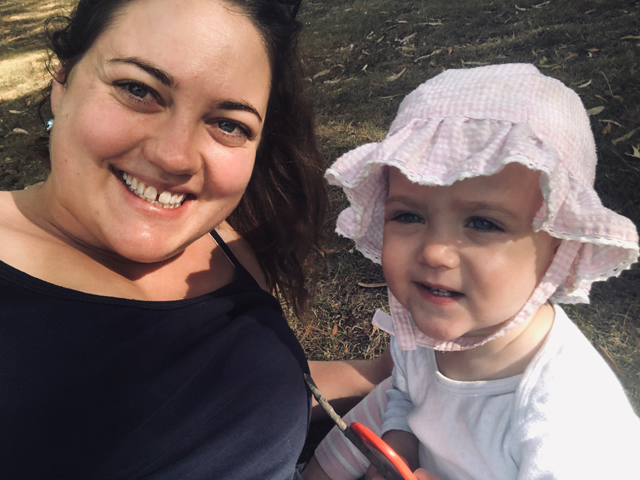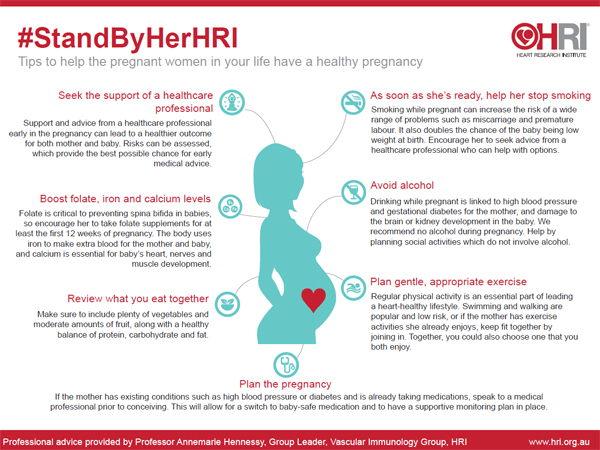Renee Harvey #StandByHerHRI Interview

Heart Research Institute Launches #StandByHer To Support Mums-To-Be To Reduce Their Risk Of Heart Disease
In Australia, cardiovascular disease continues to take the lives of 22 females every day – killing almost three times more women than breast cancer. Preeclampsia and gestational diabetes developed during pregnancy, can significantly increase a woman's risk of heart disease later in life, but these can be manageable complications if monitored.
Each year 30,000 pregnant women in Australia will develop high blood pressure during their pregnancy, with 10,000 of these leading to preeclampsia. Further still, between 12-14 per cent of pregnant women will develop gestational diabetes.
Launching in-line with World Preeclampsia Day (Wednesday, 22 May), #StandByHerHRI is an educational movement from the Heart Research Institute (HRI) targeting the support network around expectant and new mothers.
"Heart disease is a leading killer of Australian women. Due to the heightened risks during pregnancy, it is especially important for women to take simple actions – from planning gentle exercise, to reviewing nutritional intake – for a healthier outlook post-partum and into later life," says Heart Research Institute Vascular Immunology Group Leader, Professor Annemarie Hennessy.
"We know that mum is super focused on baby's development during pregnancy, so the #StandByHerHRI campaign aims to empower the mother and those around her to support her in protecting her own health as well as baby's, and ensure that simple steps are taken to help her to keep it monitored, thereby lowering her risk of cardiovascular complications," added Professor Hennessy.
Preeclampsia
Preeclampsia (high blood pressure during pregnancy that negatively impacts mum and baby) is the most common serious medical disorder during pregnancy, with one in 10 women suffering from high blood pressure. It is the major cause of premature birth, and despite the high standards of pregnancy care in Australia, preeclampsia remains one of the major causes of stillbirths and newborn deaths in the country.
In addition, women who suffer from preeclampsia are 2-4 times more likely to develop high blood pressure in later life, twice as likely to suffer a stroke or heart attack, and their risk of death from heart-related issues increases by 1.5 times. Even more concerningly, research has also found the disease can occur prematurely, up to a decade earlier.
Gestational Diabetes
In pregnancy, the hormones from the placenta can cause a woman's cells to become insulin resistant, meaning glucose levels in the blood rise. Normally the body produces more insulin to counter this, however, for some women this doesn't happen, and they develop gestational diabetes. This can then cause excess sugars and fats to cross the placenta, meaning babies may grow larger and increase the chance of problems with the birth.
Australian mother, Josie Barber, experienced gestational diabetes during her pregnancy with baby Flynn, and is a strong campaigner for greater awareness: "As a mum-to-be, all I cared about was making sure my little bump was safe and well. I wasn't concentrating on my own health, and had no idea about heart disease, or the risks posed to pregnant women.
"The #StandByHerHRI campaign is a great way to remind mother's to be of the importance of looking after themselves as well as baby, but also to empower those around her to provide support and help keep her heart healthy," added Barber.
What You Can Do
By promising to #StandByHerHRI through monitoring her heart health during pregnancy and beyond – especially if mum develops preeclampsia or gestational diabetes – Australian partners, parents and friends can help significantly lower the risk of their loved ones developing cardiovascular issues later in life.
HRI encourages Australians to get involved and help drive awareness this World Preeclampsia Day by:
Whether you're a mum, mum-to-be, or part of mum's network of support, share a picture of you and the woman you're standing by this World Preeclampsia Day and tell us how you're keeping heart healthy with #StandbyHerHRI
Sharing on social media to help raise awareness of these preventable complications
Australians can find out more about preventing heart disease in the women in their life by downloading a fact sheet via the Heart Research Institute website. www.hri.org.au/women
Interview with Renee Harvey
Question: Can you tell us about your experience with preeclampsia?
Renee Harvey: After experiencing a number of symptoms for two weeks in my pregnancy and being in and out of hospital for high blood pressure and tests, I was eventually diagnosed with severe preeclampsia at 31.4 weeks. I was admitted immediately and had to deliver my baby a mere two day later, when I was on the cusp of full-blown eclampsia and organ failure.
 Question: Prior to pregnancy did you know about preeclampsia?
Question: Prior to pregnancy did you know about preeclampsia?
Renee Harvey: Very vaguely. I had heard of preeclampsia and knew that it was a pregnancy-associated condition related to high blood pressure but had no idea about the prevalence, the symptoms and the huge risks associated with it.
Question: What preeclampsia symptoms did you experience?
Renee Harvey: Swelling of my ankles, feet, hands and face, followed by high blood pressure and eventually vision changes, extreme reflexes and uncontrollable shaking. I think it's important to note that I didn't experience all of the symptoms but still had very severe preeclampsia, so it is so important not to wait until you experience more symptoms.
Question: Was it possible to treat your preeclampsia?
Renee Harvey: No. Even with high doses of intravenous medication designed to lower my blood pressure, it continued to rise, very quickly. The only cure was to deliver my baby.
Question: Once your baby was born, did the preeclampsia symptoms disappear?
Renee Harvey: No definitely not. It takes your body time to heal and return to a healthy state. For me, I was in and out of hospital with severely high blood pressure after birth and had to be on medication for 6 weeks.
Question: Do you do anything now to decrease your risk of developing heart disease later in life?
Renee Harvey: I really prioritise my health and well-being. I make time every day to be active.
Interview by Brooke Hunter
MORE



